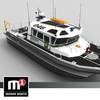LCS is On The Way
Pictured is the LCS concept from Austal.
By Fred Lash, Naval Sea Systems Command, Public Affairs Office
For anyone attending both the Surface Navy Association's 16th Annual National Symposium and the National Defense Industrial Association's "Navy-Industry International Dialogue-Littoral Combat Ship" (both on Jan. 14), the message came through loud and clear that the Littoral Combat Ship (LCS) in on its way and will be ready to take its place in America's Fleet of tomorrow. No fewer than a dozen senior Naval officers, program managers and civilian leaders described the critical need for this 21st Century warship and focused on the somewhat innovative methods that will be, utilized in its development, acquisition, and construction. For Sailors in the future Navy, it will mean a new and dynamic way of operating and maintaining a naval vessel, with new training programs that will complement the ships design. The "LCS spirit" permeated both events. Vice Admiral Phil Balisle, NAVSEA Commander, got right to the heart of the matter as he described this revolutionary warship of tomorrow. "Our Littoral Combat Ship, fully networked with the joint force at sea and ashore, will be a focused mission platform, optimized to meet the challenge of shallow water operations close inshore. It will be both built and operated in an unprecedented manner. With accelerated time lines that will see the first ship of its class delivered less than four years from now (first hull in the water in FY 07), we have a catalyst that will enact profound changes and alterations in our acquisition process. This ship will accelerate 21st Century initiatives that will see our Navy change the manner in which it designs and builds ships, interacts with coalition navies, and imbeds interoperability parameters into its shipbuilding process." All speakers and presenters reiterated the fact that the LCS will contribute to the Navy of the 21st Century in three ways:
1. It will provide unprecedented operational return on investment due to its ability to employ volume and lift at high speed and low cost to meet a wide range of operational needs, including the employment of versatile, modular, remote-vehicle based mission packages to address war-fighting requirements critical to the early stages of littoral campaigns;
2. It will serve to invigorate and shape the shipbuilding industry, especially with respect to how warships are constructed. Already industry is approaching this new demand with the scope wide-open to the advantages offered by the international community, in terms of partnership, technology, and experience; and
3. It is serving as a catalyst and venue for reshaping the Navy's ship acquisition process. To fully gain the asymmetric advantages brought about by evolving technologies, it is imperative that the acquisition time be shortened, especially the time necessary to transition from rapid prototype to production.
According to the Chief of Naval Operations, Admiral Vern Clark, "The future for the U.S. Navy-Marine Corps team requires us to dominate the near-land battle space and provide access for our joint combat team. Our enemies will continue to develop asymmetric means to stop us. LCS will be the asymmetric advantage that will allow us to dominate in this critical area of operations. We need this capability as quickly as we can get it to the Fleet."










